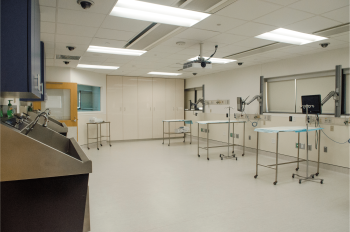
While the Non- Human Simulation areas seemed space age when they were first introduced, today it is setting the standard for education in the health care professions. Our rooms provide state-of-the art high-fidelity patient simulators, task trainers and surgical simulators to provide hands-on practice of essential skills, procedures and critical care training. A longitudinal curriculum for first-year medical students through senior residents guides trainees through progressively more complex skills and scenarios, preparing them for increasing patient care responsibilities.
Based on the concept of simulation that allows pilots to practice flying without ever leaving the ground, our center uses various technology modalities to create highly realistic scenarios for procedural training. The space can be configured to match the conditions of an operating room, emergency room or intensive care unit. In addition, highly sophisticated computer-controlled mannequins and task trainers are used to practice such techniques as airway management, emergency resuscitations, trauma care, obstetric management and teamwork skills.
High-fidelity patient simulators can be programmed with patient characteristics, such as age and anatomy. These simulators can also mimic physiological conditions, such as pulse and other vital signs, and disease processes, and vital signs can be manipulated to respond appropriately to various drugs and interventions. In the adjacent control rooms, instructors, through headsets and video monitoring, can communicate with and observe their students.
Students within the School of Medicine and Health Sciences are the primary beneficiaries of this advanced technology; however, special educational opportunities exist for medical professionals not affiliated with GW as well.
ranniger [at] gwu [dot] edu (subject: Simulation%20Center%20Information%20) (Dr. Claudia Ranniger), the medical director for Non-Human Simulation, is available to develop simulation scenarios and curricula to meet specific departmental needs.
Our Non-Human Simulation Rooms






